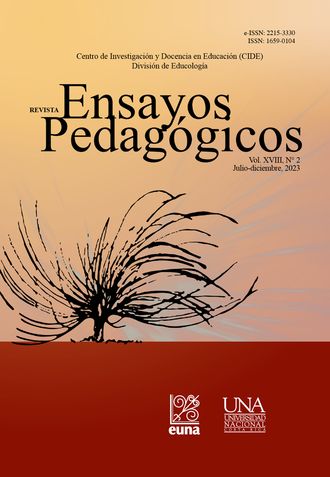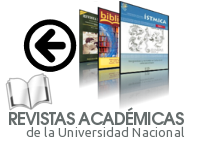Aesthetic Quality as a Research Subject in Educational Contexts. An Essay on the Normativity of the Pedagogical and the Aesthetic
DOI:
https://doi.org/10.15359/rep.18-2.3Keywords:
educational quality, educational sciences, aesthetics, researchAbstract
The notion of aesthetic quality addresses a dimension of educational processes that is still scarcely explored and linked to various modes of sensitive perception in pedagogical times and spaces. Regarding aesthetics as a constitutive dimension of educational quality in general, we examine two critical aspects for its research: 1) the normative implications of the notion of quality; 2) the normative distinctions that operate implicitly or explicitly in the pedagogical and aesthetic realm. The essay is developed in four moments. First, we present the state of the art of the research on aesthetic quality in Chile drawing on the example of research on school environment. Second, we analyze the difficulties posed by this notion in pedagogical and aesthetic terms. Third, we distinguish three types of normativity in this kind of research (perceptual, aesthetic and pedagogical). Finally, we offer some reflections on the scope and limits of researching this notion.
References
Alexander, R. (2015). Teaching and learning for all? The quality imperative revisited. International Journal of Educational Development, 40, 250–258. https://doi.org/10.1016/j.ijedudev.2014.11.012
Alonso-Sanz, A. y Zariquiey, B. (2018). Los colores, formas y manchas de la escuela desde la experiencia estética cotidiana. Contextos Educativos. Revista de Educación, 22, 229–246. https://doi.org/10.18172/con.3136
Anagnostopoulos, D., Lingard, B. and Sellar, S. (2016). Argumentation in Educational Policy Disputes: Competing Visions of Quality and Equity. Theory Into Practice, 55(4), 342–351. https://doi.org/10.1080/00405841.2016.1208071
Apple, M. (1996). El conocimiento oficial. Paidós.
Ariès, P. (1987). El niño y la vida familiar en el Antiguo Régimen. Taurus.
Aristóteles (2016). Acerca del alma. Gredos.
Baker, L. (2012). History of School Design and its Indoor Environmental Standards, 1900 to Today. National Clearinghouse for Educational Facilities. http://architecturalnetworks.research.mcgill.ca/assets/nationalinstituteofbuildingsciences-min.pdf
Baumgarten, A. (2007/1750). Ästhetik. Felix Meiner.
Benner, D. (2015). Allgemeine Pädagogik. Eine systematisch-problemgeschichtliche Einführung in die Grundstruktur pädagogischen Denkens und Handelns. Beltz Juventa.
Berliner, D. C. (2005). The Near Impossibility of Testing for Teacher Quality. Journal of Teacher Education, 56(3), 205–213. https://doi.org/10.1177/0022487105275904
Biesta, G. (2015). Resisting the seduction of the global education measurement industry: notes on the social psychology of PISA. Ethics and Education, 10(3), 348–360. https://doi.org/10.1080/17449642.2015.1106030
Blumenberg, H. (2002). Auffallen und Aufmerken. En Blumenberg, H., Zu den Sachen und zurück, 182–206. Suhrkamp.
Davies, S. (1991). Definitions of art. Cornell University Press.
Duarte, J., Gargiulo, C., y Moreno, M. (2011). Infraestructura escolar y aprendizajes en la educación básica latinoamericana: Un análisis a partir del SERCE. Banco Interamericano de Desarrollo.
Edwards, V. (1991). El Concepto de Calidad de la Educación. Oficina Regional de Educación para América Latina y el Caribe. UNESCO.
Eisner, E. W. (2002). From episteme to phronesis to artistry in the study and improvement of teaching. Teaching and Teacher Education, 18(4), 375–385. https://doi.org/10.1016/S0742-051X(02)00004-5
Eisner, E. W. (2004). What can education learn from the arts about the practice of education? International Journal of Education & the Arts, 5(4), 1–13. https://files.eric.ed.gov/fulltext/EJ808086.pdf
Engelbrecht, K. (2003). The Impact of Colour on Learning. www.merchandisemart.com/neocon/NeoConConfPro/W305.pdf
Errázuriz-Larraín, L. H. (2009). Sensibilidad estética. Un desafío pendiente en la educación chilena. Pontificia Universidad Católica de Chile.
Errázuriz-Larraín, L. H. (2015a). Calidad estética del entorno escolar: el (f)actor invisible. Arte, Individuo y Sociedad, 27(1) 81–100.
Errázuriz-Larraín, L. H. (Ed.) (2015b). El (f)actor invisible. Estética cotidiana y cultura visual en espacios escolares. https://www.cultura.gob.cl/wp-content/uploads/2015/11/factor_invisible_digital.pdf
Fechner, G. (1876). Vorschule der Ästhetik. Breitkopf & Härtel.
Fondo de las Naciones Unidas para la Infancia [UNICEF] (2000). Defining Quality in Education, Working Paper Series Education Section. https://www.right-to-education.org/resource/defining-quality-education
Gadamer, H.-G. (2003). Verdad y método I. Ediciones Sígueme.
Higgins, S. I., Hall, E., Wall, K., Woolner, P., Y McCaughey, C. (2005). The Impact of School Environments: A literature review. University of Newcastle.
Husserl, E. (2005/1952). Ideas relativas a una fenomenología pura y una filosofía fenomenológica. Libro segundo: investigaciones fenomenológicas sobre la constitución. Fondo de Cultura Económica.
Kant, I. (2006/1790). Crítica de la facultad de juzgar. Monte Ávila.
Kant, I. (2009/1803). Sobre pedagogía. Universidad Nacional de Córdoba.
Kumar, K., y Sarangapani, P. M. (2004). History of the quality debate. Contemporary Education Dialogue, 2(1), 30-52. https://doi.org/10.1177/097318490400200103
Mandoki, K. (2007). Everyday Aesthetics: Prosaics, the Play of Culture and Social Identities. Ashgate.
Marini, G. (2021). An introduction to everyday aesthetics in education. Studies in Philosophy and Education, 40(1), 39–50. https://doi.org/10.1007/s11217-020-09740-x
Marini, G. y Rodríguez-Merchán, J. (2021). Reconsidering time in schools: an everyday aesthetics perspective. Journal of Philosophy of Education, 55, 893–904. https://doi.org/10.1111/1467-9752.12592
Marini, G., Rodríguez-Merchán, J. y Salas-Aguayo, M. (2018). Estéticas cotidianas escolares: desde lo que se ve hacia cómo se siente la escuela. Educação & Sociedade, 39(143), 361–378. https://doi.org/10.1590/ES0101-73302018171876
Ministerio de Educación de Chile [MINEDUC] (2019). Bases Curriculares tercero y cuarto medio. https://bibliotecadigital.mineduc.cl/bitstream/handle/20.500.12365/14364/bases%203%c2%b0%204%c2%b0.pdf?sequence=1&isAllowed=y
Ministerio de Educación de Chile [MINEDUC] (2020). Plan de aseguramiento de la calidad de la educación 2020-2023. https://www.mineduc.cl/wp-content/uploads/sites/19/2020/07/SAC-2020-2023_vf.pdf
Organización de las Naciones Unidas para la Educación, la Ciencia y la Cultura [UNESCO] (2005). Informe educación para todos el imperativo de la calidad. https://es.unesco.org/gem-report/node/511
Organización de las Naciones Unidas para la Educación, la Ciencia y la Cultura [UNESCO] (2007). Educación de calidad para todos. Un asunto de derechos humanos. Oficina Regional de Educación para América Latina y el Caribe.
Organización de las Naciones Unidas para la Educación, la Ciencia y la Cultura [UNESCO] (2008). Quality education, equity and sustainable development: A holistic vision through UNESCO’s four World Education Conferences 2008-2009. https://silo.tips/download/quality-education-equity-and-sustainable-development-a-holistic-vision-through-u
Organización de las Naciones Unidas para la Educación, la Ciencia y la Cultura. [UNESCO] (2015). Educación 2030. Declaración de Incheon. Hacia una educación inclusiva, equitativa y de calidad y un aprendizaje a lo largo de la vida para todos. http://www.unesco.org/new/fileadmin/MULTIMEDIA/FIELD/Lima/pdf/INCHE_2.pdf
Pinar, W. (2014). La teoría del currículum. Narcea.
Platón (1988). Diálogos IV. República. Gredos.
Prange, K. (2012). Die Zeigestruktur der Erziehung. Grundriss der operativen Pädagogik. Schöningh.
Real Academia Española [RAE] (s.f.). Calidad. En Diccionario de la lengua española. Recuperado en 30 de junio de 2022, de https://dle.rae.es/calidad?m=form
Rodríguez-Garcés, C. y Padilla-Fuentes, G. (2021). Incorporación de la Ley de Gratuidad al Sistema de Educación Superior en Chile: la prolongación del subsidio a la demanda y la privatización del financiamiento público. Revista Iberoamericana de Educación Superior, 12(33), 179–195. http://doi.org/10.22201/iisue.20072872e.2021.33.864
Schäfer, A. y Thompson, C. (Ed.) (2013). Pädagogisierung. Martin-Luther-Universität.
Schirren, T. (1998). Aisthesis vor Platon. Eine semantisch-systematische Untersuchung zum Problem der Wahrnehmung. B. G. Teubner.
Schleiermacher, F. (1983/1826). Pädagogische Schriften I. Die Vorlesungen aus dem Jahre 1826. Ullstein.
Shulman, L. S. (1987). Knowledge and teaching: Foundations of the new reform. Harvard Educational Review, 57(1), 1–22.
Tardif, M. y Nuñez-Moscoso, J. (2018). La noción de “profesional reflexivo” en educación: actualidad, usos y límites. Cadernos de Pesquisa, 48(168), 388–411. https://doi.org/10.1590/198053145271
Tatarkiewicz, W. (2001). Historia de seis ideas. Arte, belleza, forma, creatividad, mímesis, experiencia estética. Tecnos.
Tuan, Y. F. (2001). Space and place: the perspective of experience. University of Minnesota Press.
Valenzuela, J., Bellei, C., y De los Ríos, D. (2013). Socioeconomic school segregation in a market-oriented educational system. The case of Chile. Journal of Education Policy, 29(2), 217–241. http://dx.doi.org/10.1080/02680939.2013.806995
Welsch, W. (2010). Ästhetisches Denken. Reclam.
Downloads
Published
How to Cite
Issue
Section
License
Copyright (c) 2024 Ensayos Pedagógicos Journal

This work is licensed under a Creative Commons Attribution-NonCommercial-NoDerivatives 4.0 International License.
Ensayos Pedagógicos is subscribed to the Attribution-NonCommertial-NoDerivatives 4.0 International Creative Commons Licence, which allows both authors and readers to freely download, store, copy, and distribute the final approved publisehd version of the manuscript (post-print) as long as this is done without commercial purposes, no derivative works are generated, and the source and author are mentioned. As well, Ensayos Pedagógicos declares that authors will remain the rightful owners of the copyrights of their work in perpetuity.







